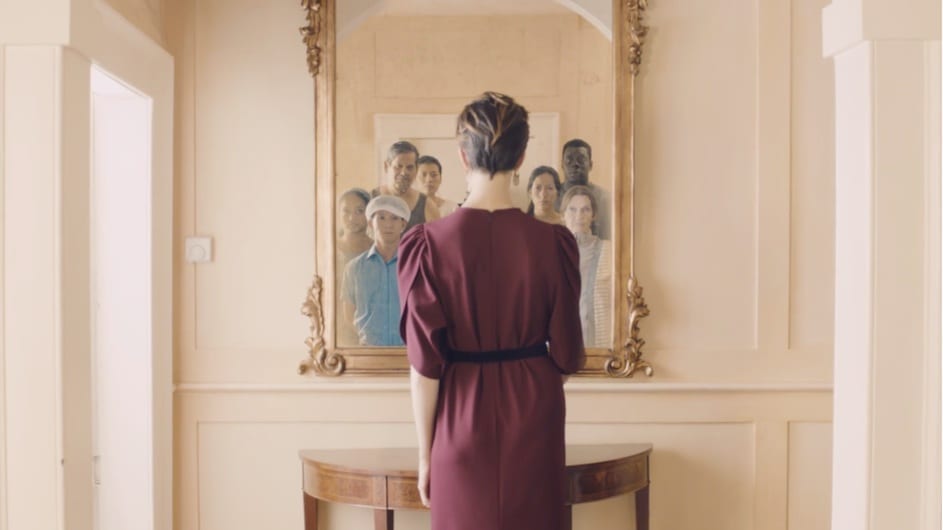How did the handprint project come about? Were you approached with a specific brief or concept or did you develop the idea and script yourself?
Livia Firth was interested in having a film to highlight the importance of sustainability in luxury fashion, whilst also speaking to the consumer at large as part of her project The Green Carpet Challenge. So with Zoe Franklin, my co-writer and a creative director, I went to meet Livia with a film idea we’d already written which focussed on the impact making clothes can have on the environment. Livia liked this initial idea but asked if we could focus on the social impact of fashion production, on the people who make our clothes, the garment workers, as opposed to the environment.
The catastrophe of the collapse of the factory in Bangladesh was fresh in all our minds, and Livia was keen to talk about the human cost of the fashion supply chain. She mentioned an Ali Hewson quote: “You carry the stories of the people who make your clothes”, and that became the inspiration for the film Zoe and I then wrote. It occurred to us that if we could see all the people who had touched our clothes before we bought them or put them on each day, we’d think very differently about what we wear, and who we buy from.
Was there something about this topic – the social footprint of the global luxury trade – that particularly appealed to you? Everyone is quick to point the finger at companies like Primark but often people don’t stop to think that the luxury brands also have a duty of care to the communities within which they operate and extract profit.
I do think that luxury fashion brands have an opportunity, as a few are already doing, to lead the fashion industry as a whole toward better standards of care and payment for the people making their clothes or products, because these brands have the power to influence people’s perception of what luxury is.
I have heard many people say recently that real luxury, true luxury, as it were, is knowing that what you are buying comes with a good story attached to it, that at every step of the process (which is a long chain) the product you are buying was made in a positive way, by people who were fairly treated. I think we’re already seeing people’s interest in origins with food production. People increasingly want to know how and where their food was made – hence the interest in organic or free-range farming.
I hope that that curiosity from the consumer about origins will spread to their wanting to know from fashion brands – whether they be luxury or high-street – how their clothes were made, with what materials, and that all of the people involved were fairly paid and working in good conditions throughout the process.
I think the change may well be driven by consumers questioning the brands, and this could start with the luxury brands – because if they make it seem like a glamourous, fashionable choice to buy things that are fairly and ethically made, then consumers could encourage other brands (at a high street level) to follow the same standards.
Awareness films can be challenging for a director at the best of times – not least of which because the subjects they address tend to ignite strong opinions and often the audience can be more critical than they are when watching a commercial or short. Was this something you thought about during this project and did you consciously seek to preempt possible points of contention while preparing the script, in casting and so on?
How the film would be interpreted and the responsibility this carried was on our minds throughout the process. We didn’t want to make a film that would shock or bully the audience into questioning how their clothes are made, or one that focussed on recent tragedies relating to garment production. We felt that it was important that the viewer gently follow the lead woman’s journey toward awareness (maybe at one step ahead of her) as she slowly realises that her clothes don’t arrive from thin air, but are handled by the many people who make them.
We were keen to present these garment workers not as victims but as people with dignity in their work, just like her, who make a living from their skills. We also had an ongoing dialogue with the financiers, when casting the film, about the nationalities of the actors playing the garment workers – they told us where the cast should come from, and we made sure that as far as possible (because we could only cast a limited number of actors to play the garment workers) that the group in the mirror she sees at the end represented a wide cross-section of nationalities.
Tell us about the production – did you have much rehearsal time to work with the extras in choreographing the precise hand movements? How did Elettra get on board? And who supplied the gowns and jewellery?
We were very lucky to have a day’s rehearsal choreographing the actors playing the garment workers. I worked with a talented choreographer called Ryan Chappell to find the movements of the workers around the lead woman, and we were able to bring a camera into the rehearsal to make sure that these movements read on camera. We also cast the actors based on how they could move their hands. I think the actors found the casting process quite unusual – they had to do a lot of caressing a curtain in the production office, so we could see what movements the actors could offer up with just their hands.
Elettra Wiedemann was suggested to us as our potential lead by Anna Wintour, who knew that as well as being a talented model, Elettra was also extremely articulate and educated about sustainability, and that the film would chime with her own interests. Although Elettra was very clear with me ahead of the shoot that she wasn’t an actress, I said that I’d feel confident guiding her performance on set, as it was as very important to us that the person playing her role understood the issues around the film. When she arrived, she impressed the whole crew with her professionalism and focus – and I am very pleased with her in the film.
The gowns in the woman’s apartment came from previous designers who had worked with Livia in making sustainable dresses for her Green Carpet Challenge project, and the jewels all came from Chopard – a brand who are currently working with Livia’s company Eco Age on a journey to sustainability. The beautiful dress Elettra wore in the film is by Stella McCartney.
What did it mean to you for this film, given its subject matter, to receive a YDA in Cannes?
I was very glad of course, to receive a YDA, above all because I hope it encourages more people to watch Handprint, and think about the origins of their clothes. It was great to go to the ceremony and see the impressive work by the other directors who won, I’m grateful to be in their company.
Are you working on any other charity or commercial projects at the moment that you can discuss?
Yes, I’ve just been commissioned to write and direct another short awareness film for The Thomson Reuters Foundation about child slavery. I didn’t know this until researching the film, but there are an estimated 29 million slaves worldwide – more than at any point in history – and many of these slaves are children. The film will be shown at the TrustWomen Conference in November, and then online. I’ve also recently finished two fashion films, and a short film for Bombay Sapphire about a speed-dating night – another subject I knew little about. Its great to have all this variety.
LINKS:









